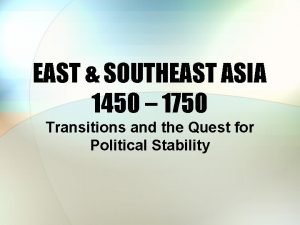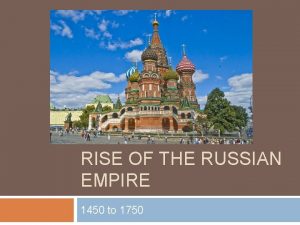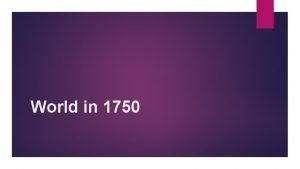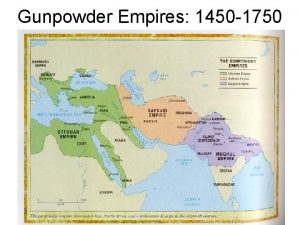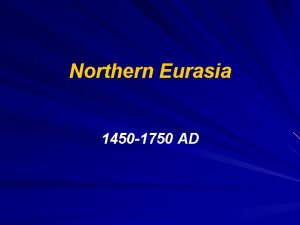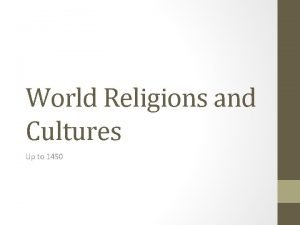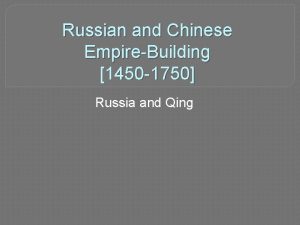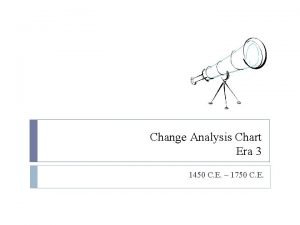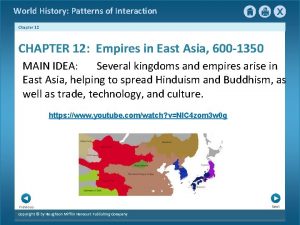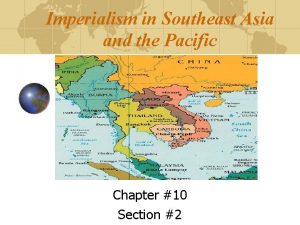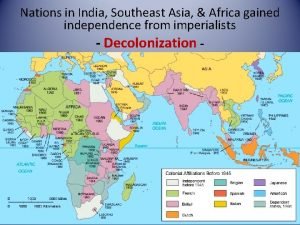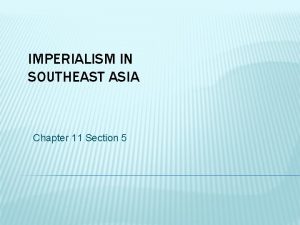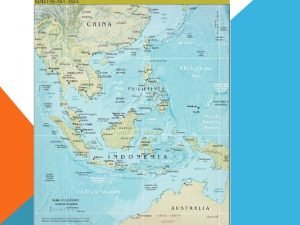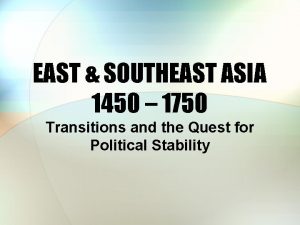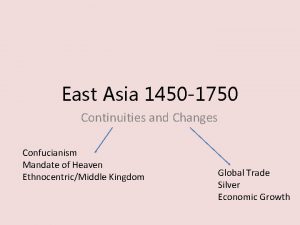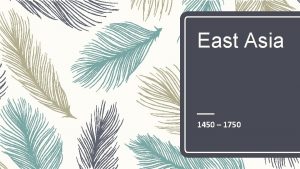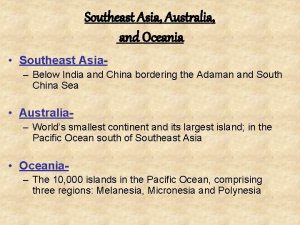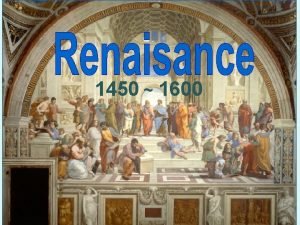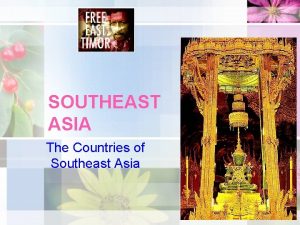EAST SOUTHEAST ASIA 1450 1750 Transitions and the
















- Slides: 16

EAST & SOUTHEAST ASIA 1450 – 1750 Transitions and the Quest for Political Stability

THE MING DYNASTY • Ming (“brilliant”) government (1368 -1644) • • • Drove the Mongols (end of Yuan dynasty) out of China • Constantly faced threats rebuilt great wall • Centralized government control • Restored traditions, bureaucracy, civil service exam Ming attempted to recreate the past, not improve upon it Yongle Moved capital to Beijing Ming decline • • • Centralized government ran poorly under weak emperors Weak emperors isolated by eunuchs, advisors Public works fell into disrepair Coastal cities, trade disrupted by pirates, 1520 – 1560 Famines and peasant rebellions: 1630 s and 1640 s Rebellion by army units opens door to nomadic invasion Nomadic Manchu invaders led to final Ming collapse, 1644

THE QING DYNASTY • Manchus (1644 -1911) • Nomadic invaders • • • Originated in Manchuria Organized by Nurhaci Proclaimed Qing (“pure”) dynasty Originally pastoral nomads Military force called banner armies Captured Mongolia first, then China Remained an isolated ethnic elite Emperor Kangxi (1661 -1722) Confucian scholar; effective, enlightened ruler Conquered Taiwan Extended control to Central Asia, Tibet, Sinkjiang Emperor Qianlong (1736 -1795) • • • A sophisticated and learned ruler, poet, and artist Vietnam, Burma, Nepal made vassal states of China was peaceful, prosperous, and powerful

SON OF HEAVEN & SCHOLAR BUREAUCRATS • Ming, Qing reestablish Sui, Tang, Song system • • • Emperor considered "the son of heaven" • • Heavenly powers, maintained order on the earth Privileged life, awesome authority, paramount power Kowtow in his presence Governance of the empire • • • Fell to civil servants, called scholar-bureaucrats Schooled in Confucian texts, calligraphy Examination system and Chinese society • • • Neo-Confucianism predominated Not nearly as flexible or vibrant as the previous system Civil service exam intensely competitive Few chosen for government positions Confucian curriculum fostered common values

THE PATRIARCHAL SYSTEM • • Ming restored social system; Qing maintained traditions Basic unit of Chinese society =Family • • filial piety Family mirrored state-individual relations Confucian duties of loyalty, reciprocity Important functions of clan, extended families • • Educate poor relatives, maintain order, organize economy, and maintain welfare of all Gender relations • • • Female infanticide; widows encouraged to commit suicide Footbinding of young girls increased Lowest status person in family was a young bride

POPULATION GROWTH, ECONOMIC DEVELOPMENT • Intense garden-style agriculture fed a large population • • • Chinese began to expand to South, Yangtze valley, clear forested lands American food crops in seventeenth century Population growth: 80 million in 14 th century to 300 million in 1800 Manufacturing and trade benefited from abundant, cheap labor Internal Commerce and Foreign trade • Both expanded under Ming tremendously • • • Brought wealth to the dynasty, merchants Threatened Confucian scholar-bureaucrats Kangxi began policy of strict control on foreign contact • • • Exported tea, lacquer, silk, porcelain Imported gold, exotics, spices Western merchants restricted to ports of Macao and Quangzhou Western merchants often had to act through Chinese intermediaries Government and technology • China (along with much of Asia) was a labor intensive economy • Ming, Qing dynasties considered technological change disruptive • • Abundant skilled labor, why not use it Preferred political and social stability.

THE SOCIAL SYSTEM (top to bottom) • • Dynastic Family Privileged classes • • Peasants • • Largest class Artisans, other skilled workers • • Some economic status Merchants • • Scholar-bureaucrats: passed the civil examinations Landed gentry: inherited land, wealth, titles Included priests, monks of Confucians, Taoists, Buddhists Often powerful and wealthy Had little social status as they made wealth through money Lower classes: slaves, servants, entertainers prostitutes

TRADITION & NEW CULTURAL INFLUENCES • Neo-Confucianism • • Education, traditions supported by Ming and Qing emperors Popular culture • Expanded to include novels, romances, travel adventures • • • Example: The Romance of the Three Kingdoms – novel set around fall of Han dynasty Imperial cultural projects: encyclopedias and libraries Christianity comes to China • • • Nestorian Christians not unknown in China, but had little influence Portuguese brought Catholicism to China, courts • Matteo Ricci (1552 -1610), an Italian Jesuit in the Ming court • • A learned man who mastered written and oral Chinese Impressed Chinese with European science and mathematics Popular mechanical devices: glass prisms, harpsichords, clocks Confucianism and Christianity • • • Jesuits respectful of Chinese tradition, but won few converts Franciscan, Dominican missionaries criticized Jesuits' tolerance When pope upheld critics, Emperor Kangxi denounced Christianity

TOKUGAWA SHOGUNATE IN JAPAN TO 1867 • The Warring States Period • • • 15 th century: Japanese civil war breaks out Japan divided into warring feudal estates Nobunaga, Hideyoshi attempt to unite Japan • Nobunaga • • Toyotomi Hideyoshi • • • Innovative, brilliant general, merciless, from a minor family Deposed Ashikaga shogun, tries to conquer Japan Assassinated by vassal general Ablest general to Nobunaga but son of a peasant Wanted to break hold of daimyo, samurai Unites Japan temporarily 1590 Invades Korea; threatens to invade China, Philippines Tokugawa Ieyasu • • • General to Hideyoshi, from a minor family Conquered Kanto, richest part of Japan Ended Korean campaign, concentrates on ruling Japan Wins civil war in 1600, establishes shogunate in 1603 Moves capital to Edo (Tokyo), reestablishes stability First need to control the daimyo, powerful local lords • • Each daimyo absolute lord within his domain Tokugawa required daimyo to live alternative years at Edo Bakufu controlled daimyo marriages, travel, expenditures Daimyo allowed to rule lands, paid tax to the shogun

TOKUGAWA GOVERNMENT 1. 2. 3. 4. 5. 6. 7. 8. 9. 10. Emperor was honored as the head of state Actual power was held by the shogun Japan was an example of a centralized feudal state The title of shogun was hereditary within the Tokugawa family Shogun was in charge of courts, finance, appointed all officials Shogun was head of the army; made all grants of land to daimyo Daimyo were land holding samurai Some were powerful enough to challenge the Shogun The daimyo managed their domains or feudal possessions Greater samurai owned land but not much; lesser samurai were warriors

SELF-IMPOSED ISOLATION • The European Threat • European contacts introduced clocks, guns, printing press • Japanese learned to make guns, used them to unify Japan • Guns threatened the social order: peasants could fire one, no art! • New Ideas: Christianity • Successful in converting much of Kyushu • Christianity threatened social order • • Difficult to unify Japan, control new contacts Control of foreign contacts • Control Catholics • • • Hideyoshi ordered missionaries to leave Not enforced closely at first Active persecutions began Tokugawa order Japanese to renounce faith Many thousands crucified for refusing Control Contacts • Tokugawa banned Japanese from foreign contacts, travel/trade abroad • Shoguns adopted policy of isolation • • • Japan closed to outsiders 163 s until 1854 Foreign trade was under tight restriction One Dutch ship a year allowed to come to Nagasaki • Despite policy, Japan was never completely isolated

JAPANESE SOCIAL CLASSES • Strict 4 -class system existed under Tokugawa • • Samurai at the top of social hierarchy Followed by peasants, artisans, merchants. Members of classes not allowed to change social status Others: priests, entertainers Outcasts (eta): professions considered impure were 5 th class Shoguns enacted laws governing hair style, dress, accessories Social change from 17 th to 19 th century • Peace undermined social, economic role of warrior elites • Shogun put samurai on regular salary: one koku per warrior • Samurai began to move into castle-towns, which lowered their social status • Became increasingly in debt as forced to maintain an expensive life style • Rise of the Chonin: Merchants • Cities became more numerous, populous giving rise to merchants • Over time they were to become very wealthy and powerful • Farmers • Law outlined the duties and conduct of the farmers

ECONOMIC, SOCIAL CHANGE • Population growth and urbanization • Agricultural production • • • Population rose by 1/3 from 1600 to 1700 Expansion of cities • • • Doubled between 1600 and 1700 Castle-Towns expanded: became cities Edo developed commerce, industry to support shogunate Economic and Commercial Changes • • Japanese begin to develop inter-coastal shipping Construction of well maintained national roads, bridges Crafts included carpentry, stonemasonry, sake-brewing, lacquering Japan traded sporadically with China, got American silver from China

Honshu, Hokkaido, Shikoku, Kyushu

NEO-CONFUCIANISM & JAPANESE CULTURE • Neo-Confucianism (loyalty, submission) • • • Became the official ideology of the Tokugawa But borrowing from Chinese culture avoided School of National Learning • • Scholars of "native learning“ replace Confucian teaching Tried to establish distinctive Japanese identity Shinto emphasized Japanese Buddhism • • Each variety developed its own distinctive Japanese version Chan Buddhism became Zen Buddhism Zen was the most popular with samurai Outside Learning • • • Tokugawa used outside learning if they controlled, regulated it Introduced printing press to Japan Dutch Learning • • • Japanese scholars permitted to learn Dutch After 1720 some Japanese permitted to read Dutch books Shoguns became proponents of Dutch learning by mid-18 th century European art, medicine, and science influenced Japanese scholars "Floating worlds"-- centers of urban culture • • • Included teahouses, theaters, brothels, public baths Poet, novelists, art encourage Kabuki theaters and bunraku (puppet) very popular Development of tea ceremony, martial arts Ukiyoe school of art depicted every day life

CHRISTIANITY AND JAPAN • Christian missionaries • • Dominicans, Franciscans arrived with the Portuguese Jesuits came later • • • Had significant success in sixteenth century with samurai, daimyo Adopted Japanese style wording, dress, manner including speaking Japanese St. Francis Xavier visited Japan Estimated that much of Kyushu including daimyo converted The Influence of Will Adams • An Englishmen who was shipwrecked in Japan with a Dutch trade mission • • • Extremely gifted linguist who became friend, advisor to Tokugawa; became a samurai Adams was Protestant and hated Catholics; was very honest about facts with Tokugawa The real man behind Clavel’s great piece of fiction, Shogun Heavily influenced how Tokugawa came to see Catholics Anti-Christian campaign • Launched by Tokugawa shoguns • • Feared anything that might help daimyos, weaken shogun Many daimyo were in contact with Europeans for weapons Buddhists and Confucians resented Christian exclusivity After 1612, Christians banned from islands • • • Tokugawa Ieyasu told Catholics to renounce faith Many did, many more were crucified Thousands went underground only to reappear in 1854
 Southeast asia 1450 to 1750
Southeast asia 1450 to 1750 Russian empire military 1450 to 1750
Russian empire military 1450 to 1750 Mughal empire 1450 to 1750
Mughal empire 1450 to 1750 Fur trade ap world history
Fur trade ap world history Land based empires 1450 to 1750
Land based empires 1450 to 1750 Japan 1450-1750
Japan 1450-1750 Religion in 1450 to 1750
Religion in 1450 to 1750 Splitski nadbiskup 1450
Splitski nadbiskup 1450 Change analysis chart 1450 to 1750
Change analysis chart 1450 to 1750 Mainland southeast asia
Mainland southeast asia Chapter 12 section 5 kingdoms of southeast asia and korea
Chapter 12 section 5 kingdoms of southeast asia and korea Imperialism in southeast asia and the pacific
Imperialism in southeast asia and the pacific Urban realms model
Urban realms model Landform in asia
Landform in asia Is india southeast asia
Is india southeast asia Imperialism in southeast asia chapter 27 section 5
Imperialism in southeast asia chapter 27 section 5 Southeast asia climate
Southeast asia climate
